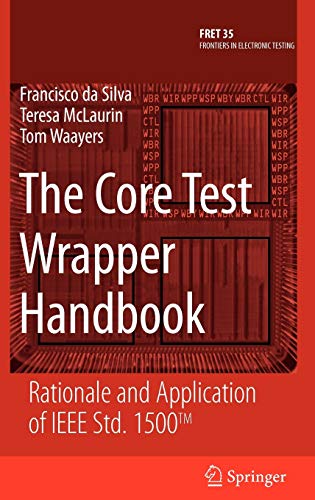core test wrapper handbook von silva francisco (7 Ergebnisse)
Suchfilter
Produktart
- Alle Product Types
- Bücher (7)
- Magazine & Zeitschriften (Keine weiteren Ergebnisse entsprechen dieser Verfeinerung)
- Comics (Keine weiteren Ergebnisse entsprechen dieser Verfeinerung)
- Noten (Keine weiteren Ergebnisse entsprechen dieser Verfeinerung)
- Kunst, Grafik & Poster (Keine weiteren Ergebnisse entsprechen dieser Verfeinerung)
- Fotografien (Keine weiteren Ergebnisse entsprechen dieser Verfeinerung)
- Karten (Keine weiteren Ergebnisse entsprechen dieser Verfeinerung)
- Manuskripte & Papierantiquitäten (Keine weiteren Ergebnisse entsprechen dieser Verfeinerung)
Zustand Mehr dazu
- Neu (7)
- Wie Neu, Sehr Gut oder Gut Bis Sehr Gut (Keine weiteren Ergebnisse entsprechen dieser Verfeinerung)
- Gut oder Befriedigend (Keine weiteren Ergebnisse entsprechen dieser Verfeinerung)
- Ausreichend oder Schlecht (Keine weiteren Ergebnisse entsprechen dieser Verfeinerung)
- Wie beschrieben (Keine weiteren Ergebnisse entsprechen dieser Verfeinerung)
Einband
Weitere Eigenschaften
- Erstausgabe (Keine weiteren Ergebnisse entsprechen dieser Verfeinerung)
- Signiert (Keine weiteren Ergebnisse entsprechen dieser Verfeinerung)
- Schutzumschlag (Keine weiteren Ergebnisse entsprechen dieser Verfeinerung)
- Angebotsfoto (4)
Sprache (1)
Preis
- Beliebiger Preis
- Weniger als EUR 20 (Keine weiteren Ergebnisse entsprechen dieser Verfeinerung)
- EUR 20 bis EUR 45 (Keine weiteren Ergebnisse entsprechen dieser Verfeinerung)
- Mehr als EUR 45
Gratisversand
Land des Verkäufers
Verkäuferbewertung
-
The Core Test Wrapper Handbook: Rationale and Application of IEEE Std. 1500 (Frontiers in Electronic Testing, 35)
Anbieter: Romtrade Corp., STERLING HEIGHTS, MI, USA
Zustand: New. This is a Brand-new US Edition. This Item may be shipped from US or any other country as we have multiple locations worldwide.
-
The Core Test Wrapper Handbook: Rationale And Application Of Ieee Std. 1500 (frontiers In Electronic Testing)
Anbieter: Romtrade Corp., STERLING HEIGHTS, MI, USA
Zustand: New. This is a Brand-new US Edition. This Item may be shipped from US or any other country as we have multiple locations worldwide.
-
EUR 113,52
EUR 7,38 für den Versand von Vereinigtes Königreich nach USAAnzahl: 1 verfügbar
In den WarenkorbZustand: New. pp. 312 52:B&W 6.14 x 9.21in or 234 x 156mm (Royal 8vo) Case Laminate on White w/Gloss Lam.
-
The Core Test Wrapper Handbook | Rationale and Application of IEEE Std. 1500(TM)
Anbieter: preigu, Osnabrück, Deutschland
Taschenbuch. Zustand: Neu. The Core Test Wrapper Handbook | Rationale and Application of IEEE Std. 1500(TM) | Francisco Da Silva (u. a.) | Taschenbuch | xxix | Englisch | 2014 | Springer US | EAN 9781489987693 | Verantwortliche Person für die EU: Springer Verlag GmbH, Tiergartenstr. 17, 69121 Heidelberg, juergen[dot]hartmann[at]springer[dot]com | Anbieter: preigu.
-
The Core Test Wrapper Handbook : Rationale and Application of IEEE Std. 1500¿
Anbieter: AHA-BUCH GmbH, Einbeck, Deutschland
Taschenbuch. Zustand: Neu. Druck auf Anfrage Neuware - Printed after ordering - In the early to mid-1990's while working at what was then Motorola Se- conductor, business changes forced my multi-hundred dollar microprocessor to become a tens-of-dollars embedded core. I ran into first hand the problem of trying to deliver what used to be a whole chip with something on the order of over 400 interconnect signals to a design team that was going to stuff it into a package with less than 220 signal pins and surround it with other logic. I also ran into the problem of delivering microprocessor specification verifi- tion - a microprocessor is not just about the functions and instructions included with the instruction set, but also the MIPs rating at some given f- quency. I faced two dilemmas: one, I could not deliver functional vectors without significant development of off-core logic to deal with the reduced chip I/O map (and everybody's I/O map was going to be a little different); and two, the JTAG (1149. 1) boundary scan ring that was around my core when it was a chip was going to be woefully inadequate since it did not support - speed signal application and capture and independent use separate from my core. I considered the problem at length and came up with my own solution that was predominantly a separate non-JTAG scan test wrapper that supported at-speed application of launch-capture cycles using the system clock. But my problems weren't over at that point either.
-
EUR 178,14
EUR 48,99 für den Versand von Deutschland nach USAAnzahl: Mehr als 20 verfügbar
In den WarenkorbGebunden. Zustand: New. Guides engineers through the process of building a 1500 wrapperProvides insight into the rules and recommendations of IEEE Std. 1500 Focus on practical design considerations inherent to the application of IEEE Std. 1500 by discussing design choice.
-
The Core Test Wrapper Handbook : Rationale and Application of IEEE Std. 1500(tm)
Anbieter: AHA-BUCH GmbH, Einbeck, Deutschland
Buch. Zustand: Neu. Neuware - In the early to mid-1990's while working at what was then Motorola Se- conductor, business changes forced my multi-hundred dollar microprocessor to become a tens-of-dollars embedded core. I ran into first hand the problem of trying to deliver what used to be a whole chip with something on the order of over 400 interconnect signals to a design team that was going to stuff it into a package with less than 220 signal pins and surround it with other logic. I also ran into the problem of delivering microprocessor specification verifi- tion - a microprocessor is not just about the functions and instructions included with the instruction set, but also the MIPs rating at some given f- quency. I faced two dilemmas: one, I could not deliver functional vectors without significant development of off-core logic to deal with the reduced chip I/O map (and everybody's I/O map was going to be a little different); and two, the JTAG (1149. 1) boundary scan ring that was around my core when it was a chip was going to be woefully inadequate since it did not support - speed signal application and capture and independent use separate from my core. I considered the problem at length and came up with my own solution that was predominantly a separate non-JTAG scan test wrapper that supported at-speed application of launch-capture cycles using the system clock. But my problems weren't over at that point either.






